Could you drill into magma and trigger an eruption? A How-to Guide, Part 1
Past experiences drilling into magma reveal a lot about whether you could start an eruption on purpose.
This post got too long as I was writing it so I’ve split it in two. Here’s the first part about historical encounters drilling magma. The second will cover triggered eruptions.
Some years ago, I had an interesting discussion about whether humans might intentionally trigger a volcanic eruption. This was back when it was unbecoming to talk about climate geoengineering in polite company but that seems to be shifting now. Anyway, the gist of the argument went something like this.
We know that large eruptions create some short-lived climate cooling. We need more climate cooling. What if we triggered an eruption to encourage cooling? How could we do that?
Setting aside the obvious safety and ethical issues (toxic gases, flight disruptions), we brainstormed and eventually settled on finding and drilling a shallow magma body. Being rock that’s hot enough to flow like a liquid, the magma might then rise and ‘erupt’ out the top of the borehole.
As ever, it seems there are no truly new ideas. Magma has been drilled several times (in Iceland, Hawai’i and Kenya) and at least one eruption has occurred through a well (Iceland again). So this post and its sequel are a brief tour through those encounters ahead of sketching out a plan for how you’d do it on purpose (it would be very difficult).
Careful where you dig
Iceland is an enormous rift, which is a region of the Earth where the crust is literally tearing apart. So naturally, you’ll find a lot of magma, volcanoes and geothermal systems (I wrote about the latter here). In 2009, a group of scientists and drillers went to one such geothermal system, Krafla, and set about drilling a new kind of well. The new well, designated IDDP-1, had the goal of reaching 4.5 km depth in search of supercritical water hotter than 374°C. Instead, they encountered magma (and also, supercritical water at 450°C).
Drilling a well involves rotating a pipe for a long period of time while cutting teeth at the end of the pipe grind away at rock. The drilling experience at IDDP-1 was rather uncommon. Things proceeded normally for the first couple of kilometers, with rock getting ground up and the pipe getting deeper. But then around 2.1 km the grinding part at the front of the drill (called the drill bit) got stuck and broke off. When that happens, you have to try pull it back out in an activity called fishing (no joke). Failing that, you reverse back up the hole a short distance and then start drilling a new path through the wall of the well, called a sidetrack: this is what happened at IDDP-1.
While not desirable, these setbacks must be tolerated and so drilling got started again. Except that then the bit just got stuck again in the new sidetrack, at exactly the same depth. So, no real progress. One thing you can do is pull the drill back up the hole a bit and then bring it back down to try and punch through the obstruction. This didn’t work and actually the drill got stuck at an even shallower depth. Whatever was obstructing the drill bit seemed to have followed it back up the well.
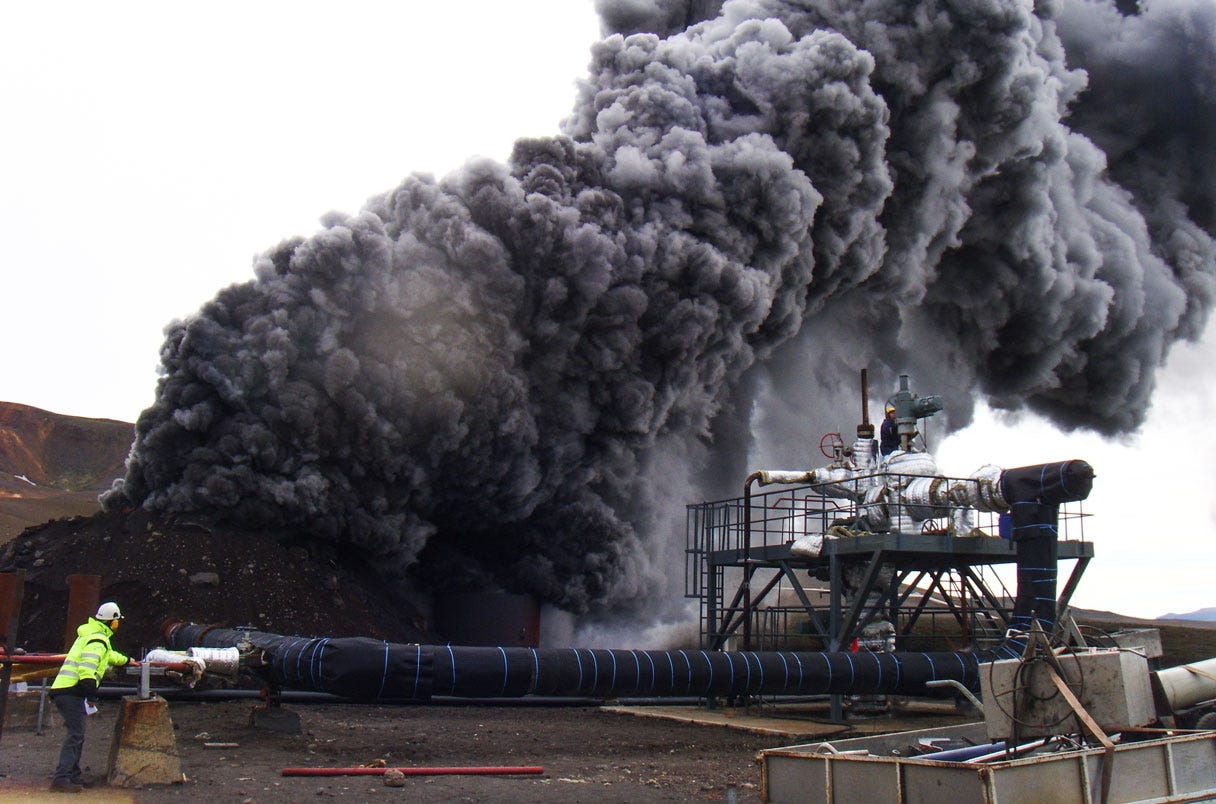
It turns out, the Iceland team had hit a shallow pocket of 900°C magma that no one knew was there. On the face of it, magma coming back up a hole towards you might raise some eyebrows. But, because this was a highly viscous1 rhyolite magma, it was actually moving quite slowly. At 2.5 meters per minute - about three times the speed of a garden snail - it would have taken 14 hours to make the top of the well. And that’s without accounting for the 2 km high column of cold, heavy drilling mud sitting above it, cooling it down. So in the end, it froze into a solid rock plug — the magma never really presented much threat of ‘eruption’.
The drillers sidetracked one last time, hitting the magma again, and so they finalised the well. It then became a pretty good steam producer for two years - 450°C and full of acid! - before a valve malfunction meant the well had to be ‘killed’ (injected with cold water to halt the steam) and ‘abandoned’ (filled with gravel and cement to close it up). Later, they dug up some of the steel in the well and found it had been damaged by a new kind of corrosion2. Clearly we’ll need better materials if we’re going after more of this supercritical steam.
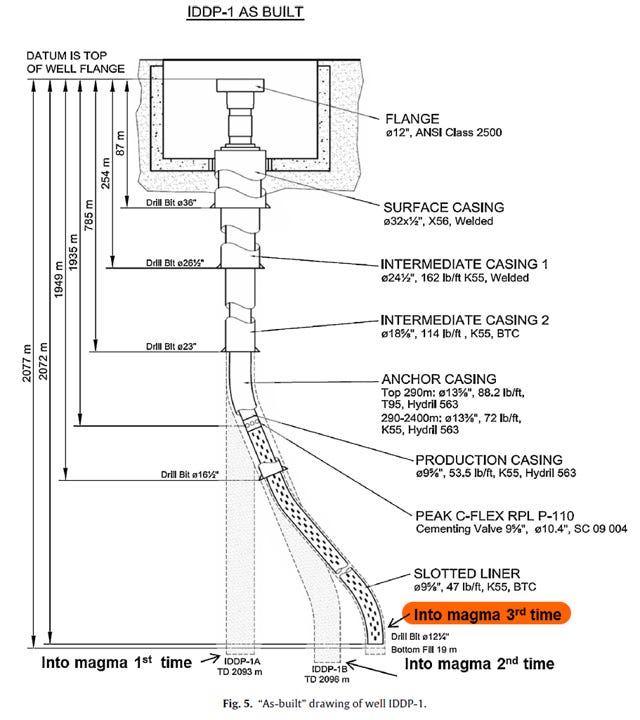
What lessons should be learned from this experience?
There can be pockets of magma hanging about at relatively shallow depths. We probably won’t know where these are ahead of time. But they’re good targets if you want to do it again.
It’s really hard to drill through magma. The drill bit is not designed for these high temperatures. The soft, viscous molten rock could adhere to the bit and create drag (think of driving a screw through thick carpet), which increases the torque required at the surface.
Magma can enter the borehole and start rising, but it does so slowly. Partly that’s because it is highly viscous but also its a lot of work to push back the weight of all the heavy drilling mud in the well above it. So getting magma all the way to the surface will be a challenge.
A magma strike does not mean a well has to be abandoned. Wells in Iceland, Hawai’i3 and Kenya4 all continued operation after magma strikes.
Drilling magma, on purpose, for science
Punching into molten rock must have scratched an itch, because the Iceland team wants to go back and do it again. The Krafla Magma Testbed (KMT) is a proposal to redrill the Krafla magma body and create a sort-of magma observatory5. Plenty of interesting science to discover and, at $100 million dollars, it’s only 2% the cost of a Large Hadron Collider. What a steal.
However, this wouldn’t be the first time that scientists have deliberately drilled into magma. The US Geological Survey has been doing this for the last 60 years at Kīlauea volcano on Hawai’i’s Big Island.
Kīlauea is an active shield volcano on the southern side of the island that regularly erupts and sends lava flowing down into the ocean, sometimes across the geothermal power plant. Other times, the lava gets held up and detained in lava lakes — temporary pondings of the molten rock. These lakes cool down and develop a hard crust over the top, which tourists can then hike across (like I did in 2015.) If nothing else, it’s remarkable how quickly the barren volcanic terrain gets colonised by ferns and something like the NZ pohutukawa.

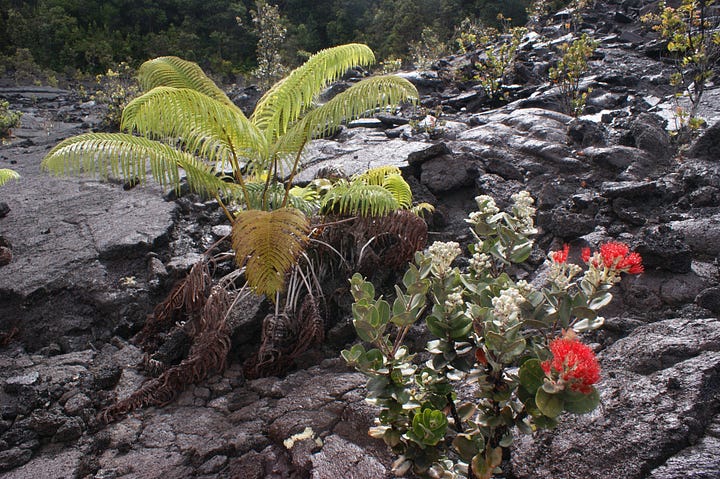
Anyway, following a 1965 eruption that formed the 84 m deep Makaopuhi Lava Lake, USGS scientists decided they had to drill into it. True frontier science of the see-something-new-and-poke-it-with-a-stick style only in this case the stick was a 1-inch, water-cooled tungsten carbide drill bit driven by a chain saw motor. Thomas Wright and Reginald Okamura describe their experiences in a 1977 USGS report. For instance, they knew they’d made it through the solidified crust on top and into the magma because the drill started to fall away under its own weight. But watch out because
“[the] coolant water introduced into melt already supersaturated in H2O collects as a giant “bubble”, and when the drill string is disconnected the water is expelled as a blast of superheated steam.”
Once, when they pushed their way into the molten rock “drilling . . . resulted in eruptions of gushers of glassy black sand to the surface . . . produced by the quenching of melt to a glass . . . [that] then shattered because of thermal stresses.”6 This melt had been thermally extinguished on its way back up the hole, losing too much heat to the rock that formed the wall of the well. So, not really a magma eruption. Nevertheless, it would have been compelling to witness firsthand.
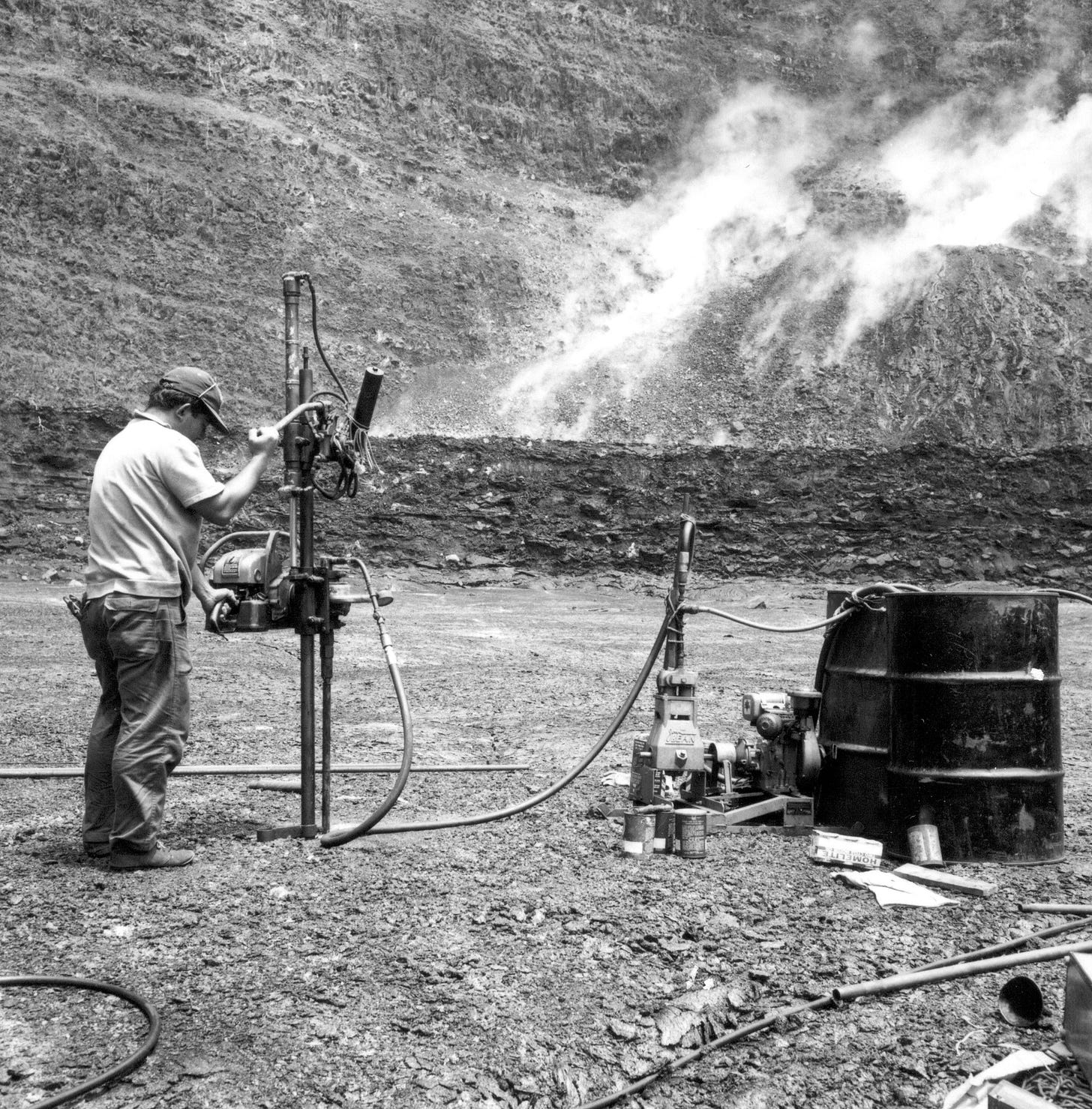
Other times, the drillers tried to extract an intact core of rock. They do this by drilling a special hollow barrel around the rock, then breaking off and withdrawing the column of rock inside. However,
“while drilling . . . the cooling water was insufficient to quench the melt and molten basalt poured into the core barrel. The drill stem was pulled with difficulty, and the core barrel contained a 5-foot-long sample of almost pure glass”
Different teams continued to drill Makaopuhi and Kīlauea Iki lava lakes over the years. Some of their adventures included:
Trying to drill all the way to the bottom of the lava lake before their equipment melted.
Blasting the magma with high-pressure jets of water to freeze it before drilling into it (Sandia’s Magma Energy Project).
Losing various bits of equipment including a heat exchanger, a 30-foot furnace, thermocouples, and lots of drill bits.
Making holes and watching magma fill them back up, like you might have done (with sand and water) at the beach when you were a kid.
That last point is worth expanding on because it does hint at how a borehole magma eruption might occur. The 1983 USGS report from Rosalind Helz and Thomas Wright describes a series of wells drilled to a known depth, left for a while, and then re-entered to discover what was in them. They describe these holes as being filled by a filter-pressed liquid melt — that is, the magma mixture of solid rock crystals and liquid melt is squeezed by the weight of the lava lake above such that the liquid melt is pushed out into the well. It’s a bit like how grapes are crushed and then squeezed to separate the juice from the solid skin.
This report is a fun read if only because they refer to this ultrahot liquid that fills the well as “ooze”. In a passage that sounds awfully like it was lifted from the script of Ghostbusters, they write:
Some questions about the movement of ooze into Kilauea Iki drill holes have not yet been discussed. These include (1) the nature of the source of the ooze, (2) the depth of origin of the ooze, and (3) the physical factors causing or controlling oozing.
Through a series of observations, they eventually concluded that oozing could sometimes fill the well as fast as at Krafla (4.6 feet per minute) but other times would be a lot slower. They also didn’t think cooling of the melt had a major effect on when it stopped rising, instead suggesting it was the driving pressure from inside the lava lake that was important — after a period of oozing, this pressure gets depleted and so the ‘push’ to drive it further up the well is gone.


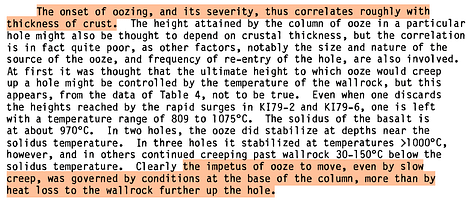
So what can we take away from these experiments?
Although drilling through magma is difficult, it is possible if you are persistent and have a decent cooling system that freezes the rock before the drill teeth try to break it.
Thermal survival of the magma is sometimes important - recall the “gushers” of quenched glass sand - and other times seems not to be (the ooze observations).
Conditions inside the magma body into which you are drilling are important, especially its pressure and how much liquid there is.
Okay, so how does that help?
In the next post, I’ll describe an actual eruption that occurred through a borehole. That also happened at Krafla, several decades ago during a series of eruptions called the Krafla Fires. Then, based on that eruption and the encounters described here, I’ll argue that this kind of ‘eruption’ is essentially a thermal survival problem. So, for a given type of magma - rhyolite or basalt - you just need to work out (1) how fast it rises and how hence long it would take to reach the top of the borehole and (2) how fast it loses heat and hence how long it will take the magma to freeze to death. Depending on which one wins, you will get your ‘eruption’ (or not).
Viscosity is a kind of internal drag. When a fluid is very viscous, it drags against itself and anything its contacting. The result is that you need considerable effort to make it go anywhere.
Hydrogen sulfide in the steam reacted with the carbon in the steel to produce methane gas, which then caused blistering.
In 2005, drillers of well KS-13 in the Puna geothermal system hit a 1050°C dacite magma at 2.5 km depth. The magma flowed about 5 meters up the borehole in several minutes before stopping. The well was then completed as an injector. Teplow et al. (2009).
In 2011, drill cuttings returned from wells MW-04 and MW-06 in Menengai geothermal system, Kenya, revealed fresh glassy, quenched cuttings from depths of 2 km. Magma turns into a kind of glass when rapidly cooled. Seeing bits of ‘young’ (fresh) glass coming back up the well tells you it probably hit some magma.
Skim this master thesis to see more the possible risks and mitigation.
Magma contains a lot of silica (SiO2). When it freezes quickly it can form a glass (e.g., obsidian) or slowly to form quartz. Sand is (mostly) a bunch of tiny quartz crystals. A volcanologist would express this better.




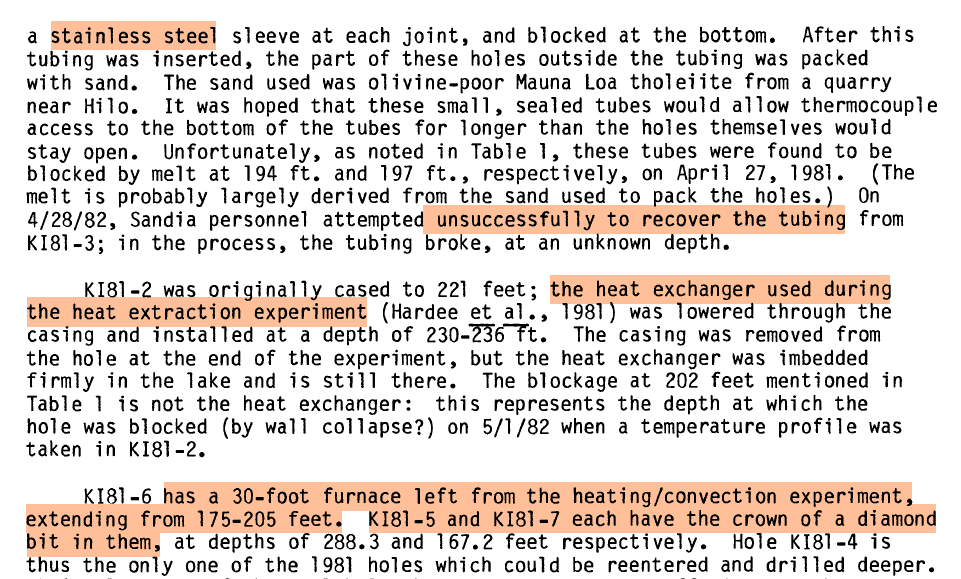
Bit like having to stir toffee while it cools. After a while, no go.
Really interesting! Thanks for writing it.